Fresh curb appeal starts at your feet: material, profile, lighting, safety, and landscaping all converge on the front steps to set the tone for an entire façade. After surveying recent design galleries, code updates, and product advances, I’ve distilled 25 practical, style-forward ideas — each one a standalone concept you can mix, match, or tackle as its own weekend project. From recycled-aggregate concrete treads to sensor-lit risers and planter-wrapped landings, these suggestions balance aesthetics, budget, and maintenance so your entry feels welcoming and future-proof. Read on for inspiration and actionable tips that turn the everyday act of climbing your front steps into a moment of delight.
1. Broad Concrete Front Steps With Lounge-Sized Landing

A generous landing at the top of front steps invites guests to pause and enjoy the view while satisfying modern code that favors deeper platforms for safety. Pour a 4-inch reinforced slab, then frame wide 14-inch treads so the staircase reads more like outdoor furniture than a utility. Edge forms that mimic natural stone faces add texture without quarry costs. Finish the concrete with a light broom for slip resistance and tint the mix a warm gray-beige to soften the look next to greenery.
2. Brick-Faced Front Steps for Timeless Texture

Nothing says heritage like brick, but pairing rich clay units with a contrasting cream mortar feels fresh on today’s façades. Lay bricks as a facing over a concrete core to keep costs predictable, and cap each tread with bull-nose brick for a finished edge. A penetrating silane sealer prevents efflorescence, preserving the crisp color that makes brick front steps pop against white clapboard or charcoal siding.
3. Rustic Timber-Sleeper Front Steps
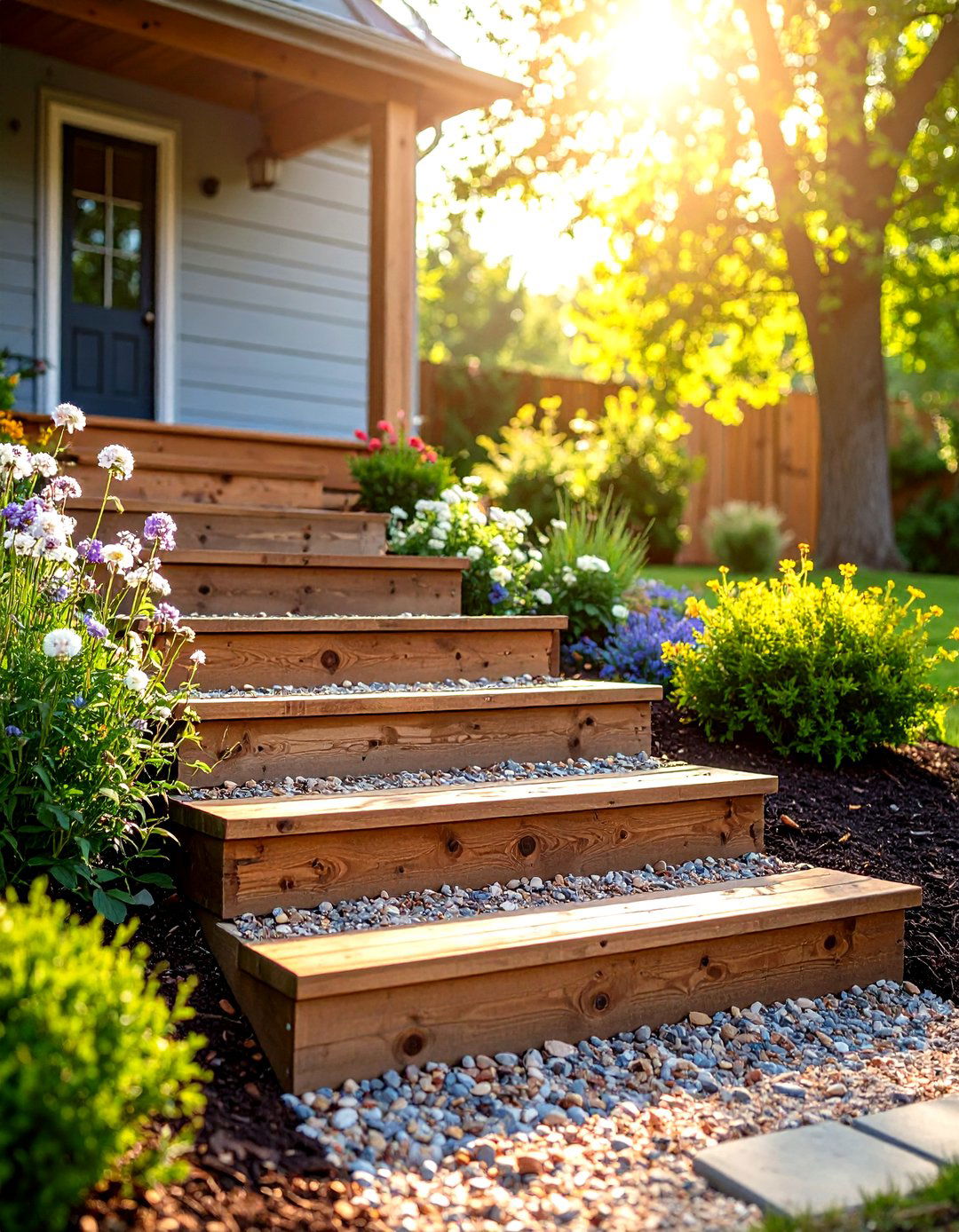
For cabins or cottage-style homes, landscape timbers stacked into broad, low rises create front steps that blend into plantings. Cut pressure-treated 6×6 sleepers to length and secure each course with rebar. Pack the interior with compacted gravel for drainage; topping with cedar mulch keeps weed pressure down. Annual clear staining retards checking so the wood ages to a silvery gray rather than splitting.
4. Floating Concrete Front Steps for a Minimalist Entry

A run of cantilevered treads seemingly suspended above a gravel bed gives front steps an art-gallery vibe. Cast each tread in glass-fiber-reinforced concrete and post-tension it to a hidden steel tube frame to avoid bulky stringers. Recessed LED strip lights under each nose turn the floating illusion into nighttime drama.
5. Natural Stone-Slab Front Steps
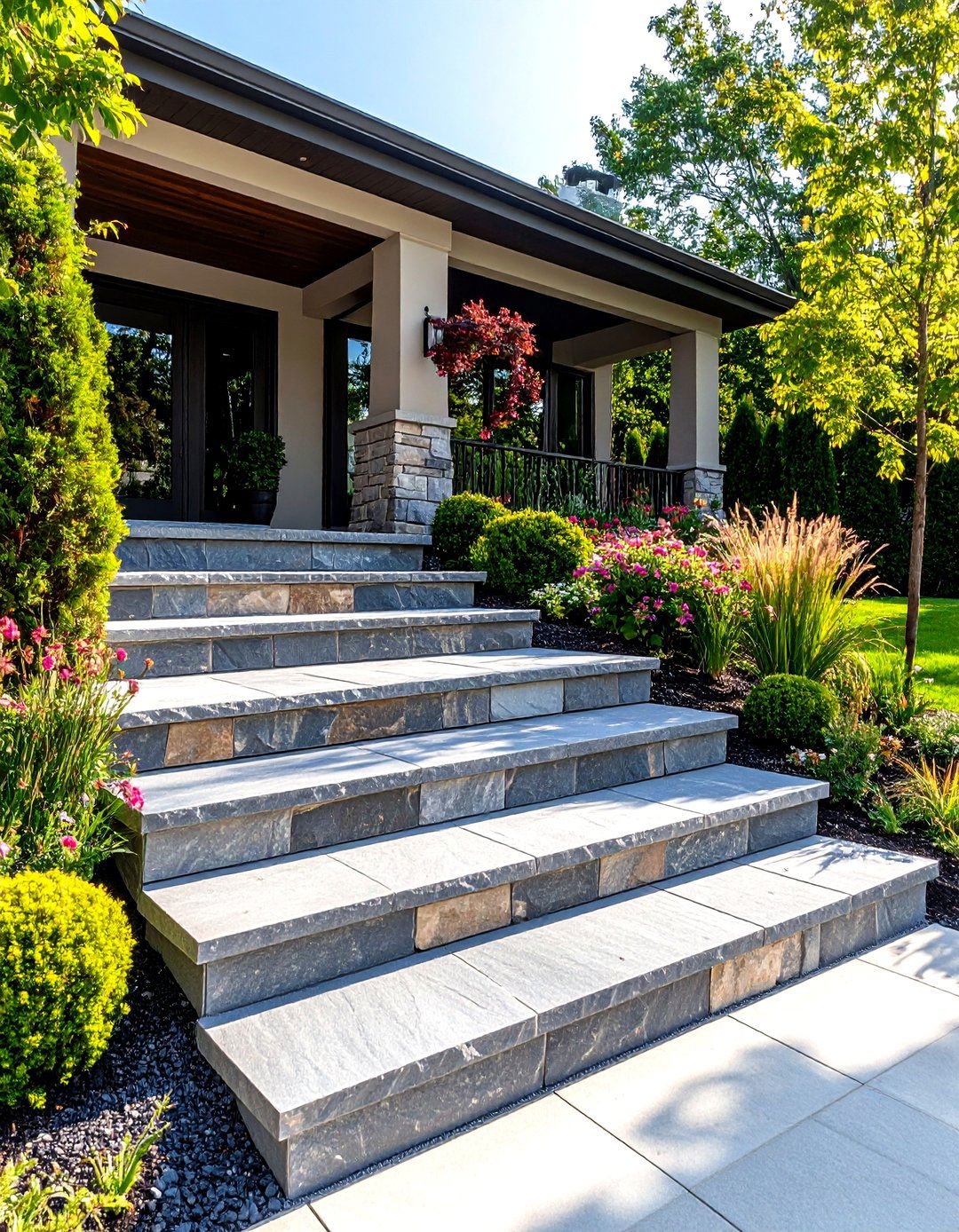
Bluestone or granite treads lend weight and longevity, standing up to freeze-thaw cycles better than poured concrete. Dry-set the slabs on a compacted gravel base with polymeric sand in joints for flexibility. Leaving slight overhangs casts elegant shadow lines that elevate even small stoops.
6. Metal-Grate Front Steps for Industrial Flair
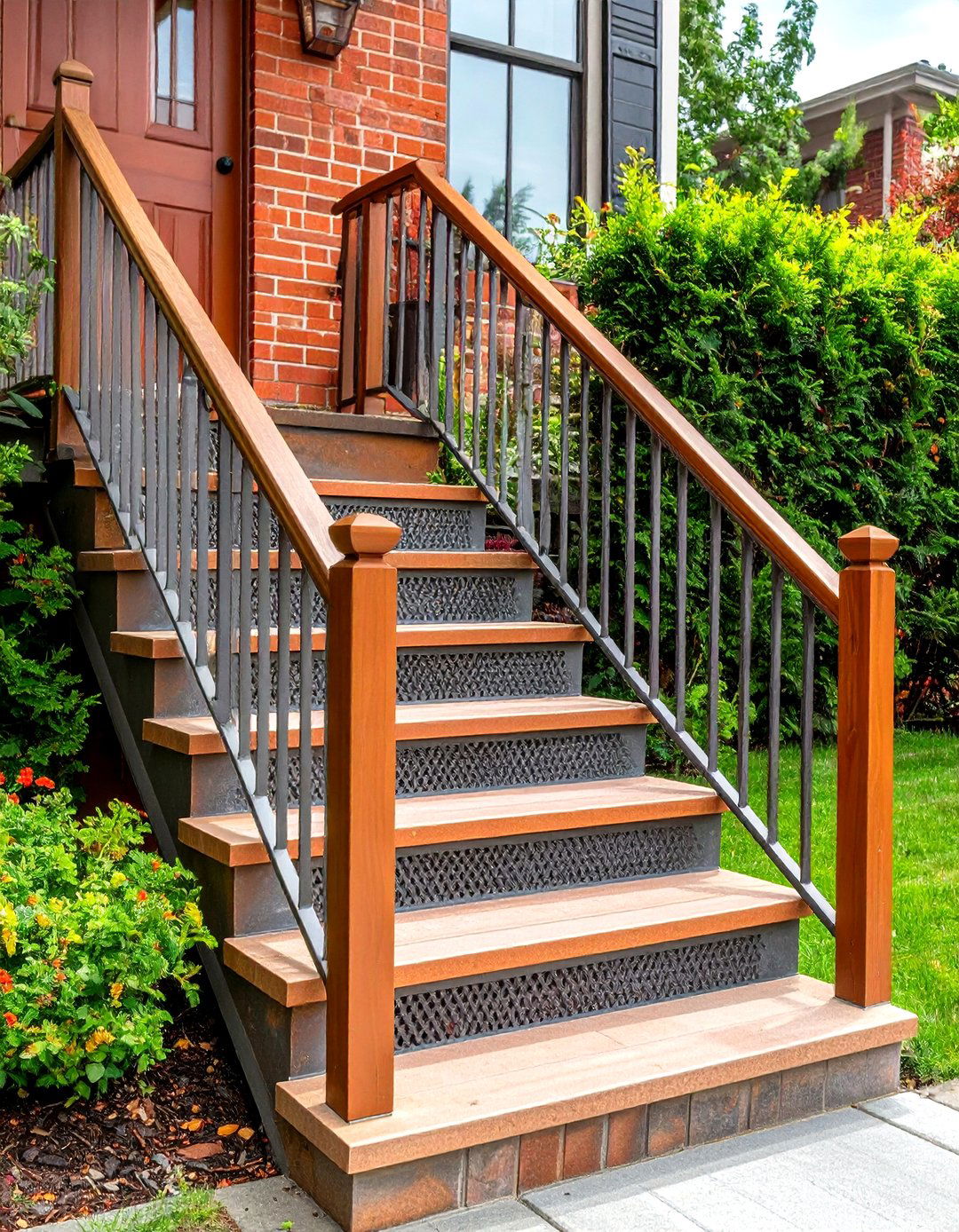
Galvanized bar-grating treads shed snow and debris instantly, a boon in wet climates. Pair the grating with a tapered steel stringer and powder-coat the assembly matte black to bridge modern and farmhouse styles. Add wood handrails to warm the touch and soften acoustics.
7. Cantilever Glass-Fiber Concrete Steps With Undercut Lighting
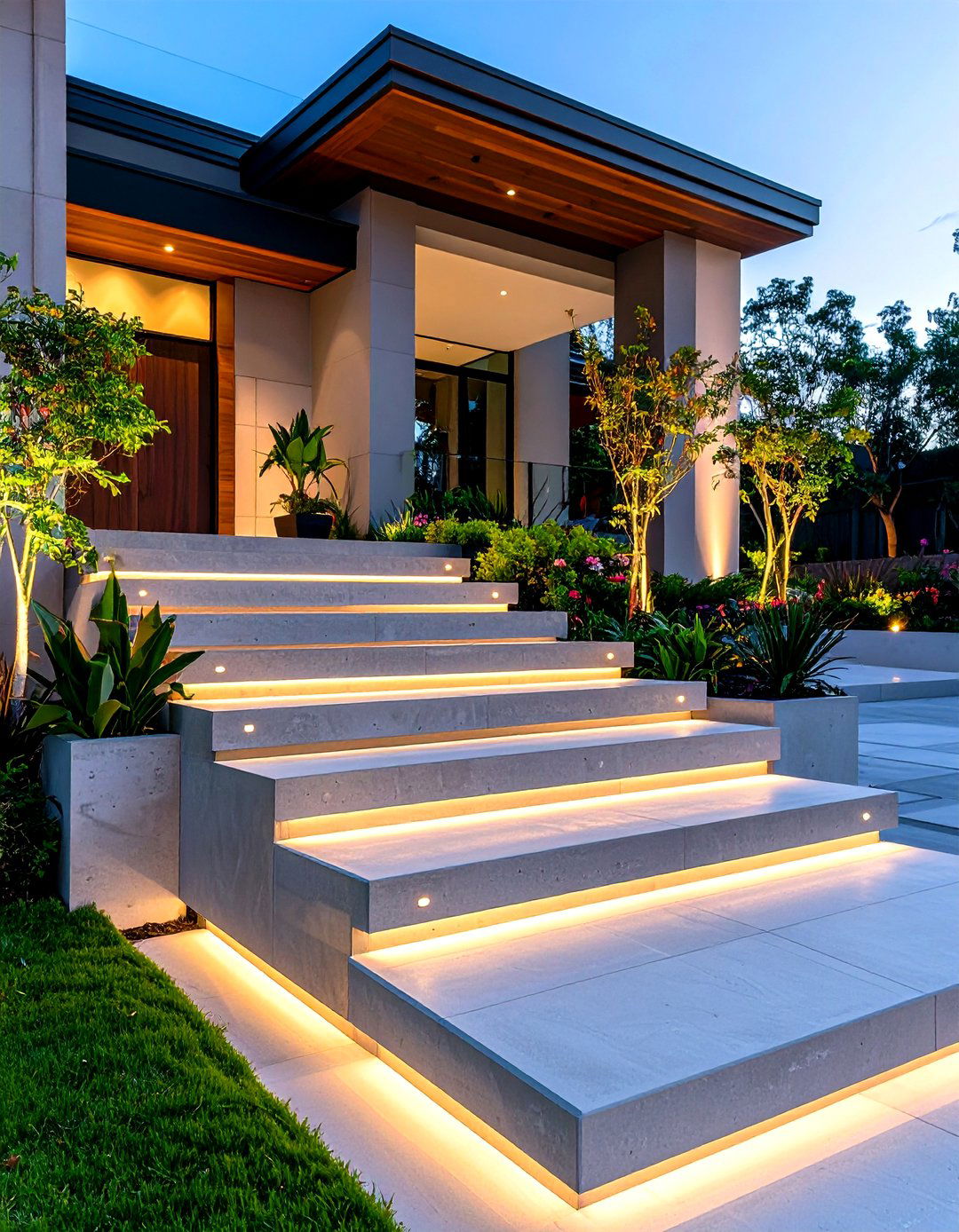
Ultra-high-performance GFRC lets you span wider than conventional mixes, so front steps can protrude dramatically without visible supports. Form an undercut beneath the nose to accept low-glare recessed puck lights; they wash each riser, guiding visitors safely while spotlighting the sculptural profile.
8. Recessed Step-Light Front Steps
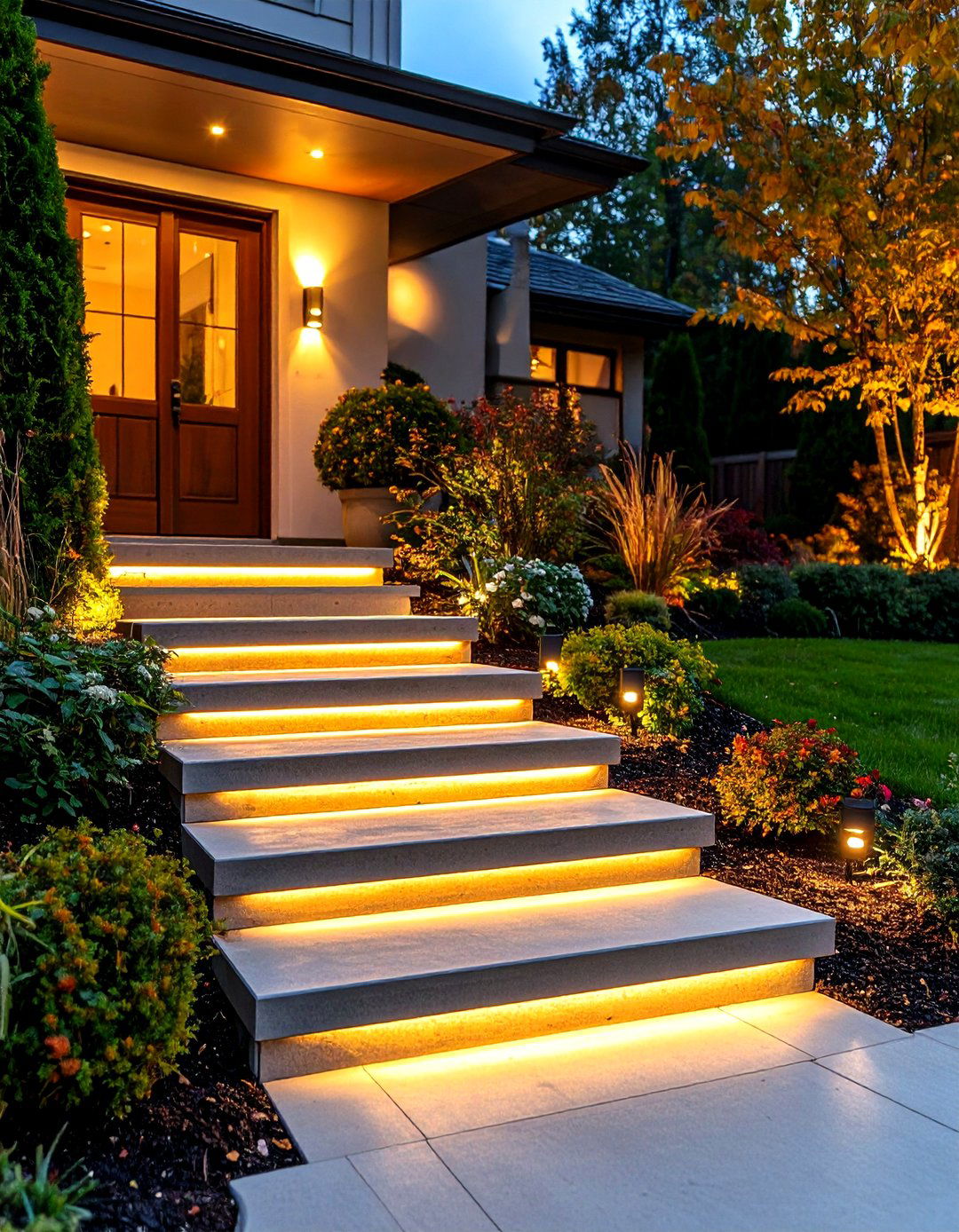
Integrated deck-style fixtures set flush into the risers keep pathways lit without casting harsh glare. Space LED step lights every other tread and wire them to a sunset-to-sunrise transformer so illumination feels effortless and energy conscious.
9. Solar Rail-Cap Lighting on Front Steps
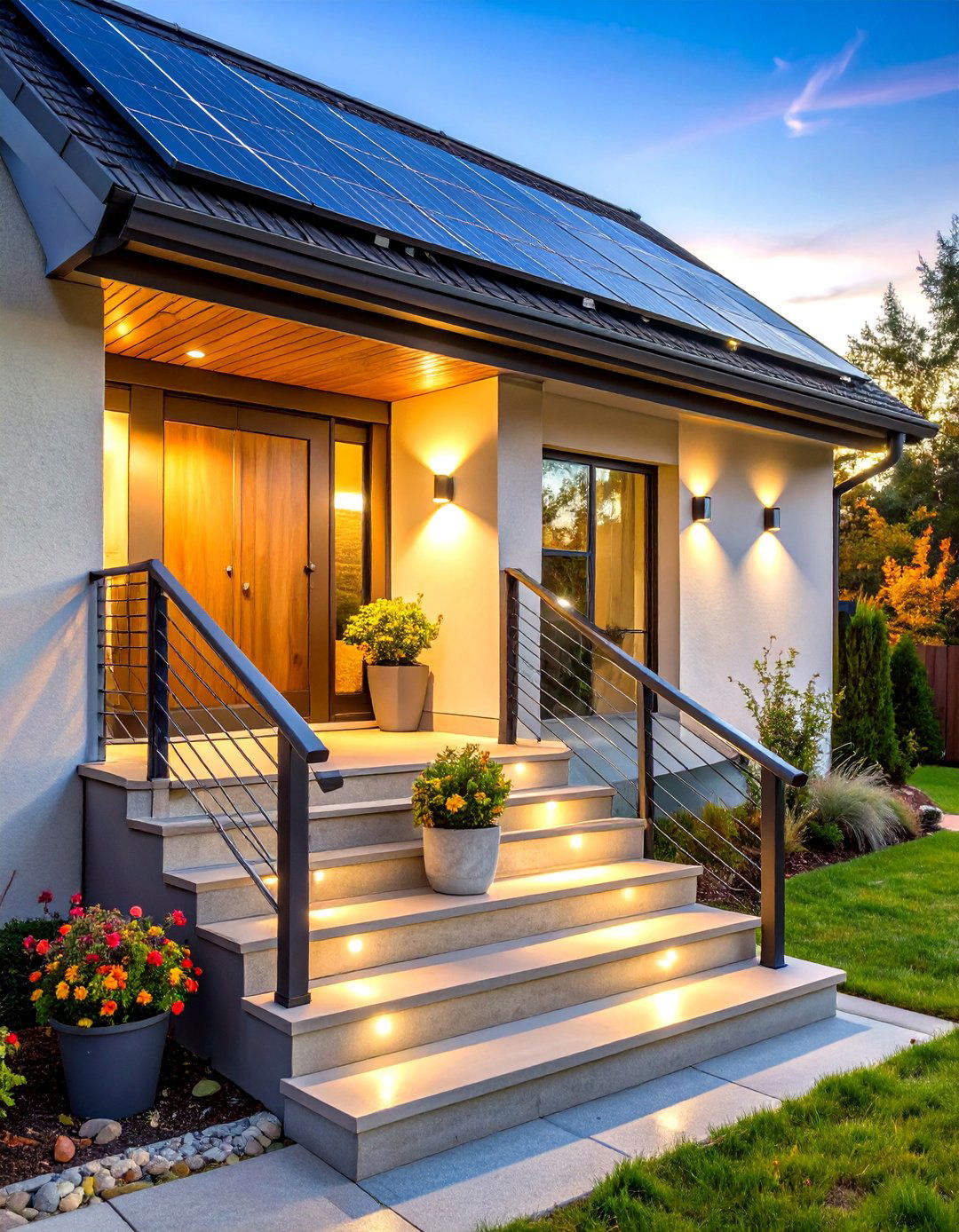
If rewiring isn’t in the cards, clip low-profile solar caps onto existing metal or wood railings flanking the front steps. Choose warm-white 2700 K LEDs for a welcoming glow that avoids the “Las Vegas” effect designers warn against when lighting gardens.
10. Decorative Tile-Riser Front Steps

Hand-painted ceramic or encaustic tiles on risers transform utilitarian front steps into art pieces. Use frost-rated tile and flexible thinset, then seal the grout with a penetrating waterproofing agent to guard against winter salt damage. Repeat one tile color on the door to tie the entry together.
11. Built-In Planter Front Steps

Extend side walls upward into deep masonry boxes that double as integrated planters, framing the staircase with year-round foliage. Lining the interior with drainage fabric prevents soil from clogging weep holes, while drip irrigation hidden under coping keeps maintenance minimal.
12. Waterfall-Edge Front Steps
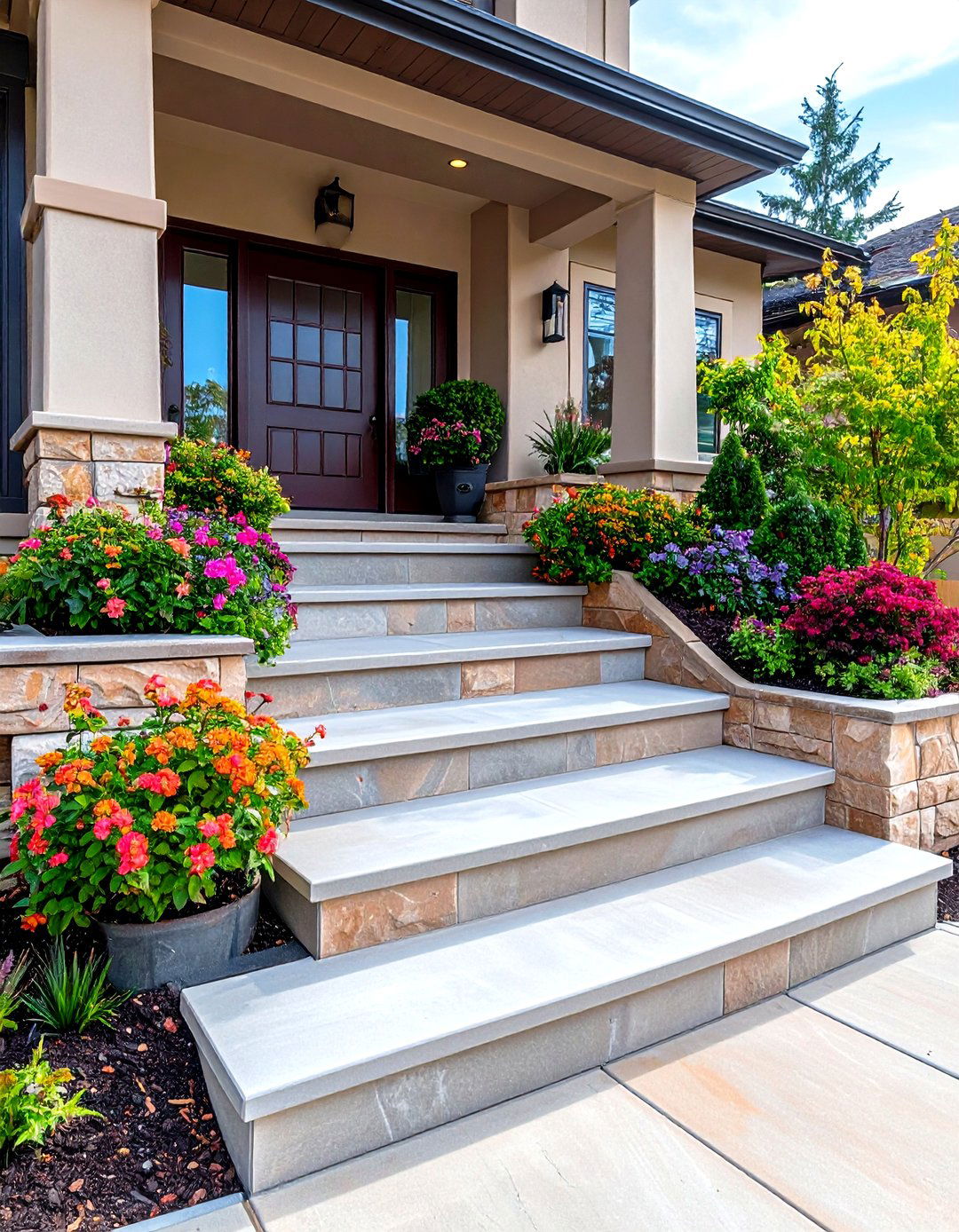
A crisp “drop edge” where the tread wraps vertically down to meet the riser hides joints and gives concrete or stone front steps a continuous slab appearance. Combine with a smooth sand-blasted finish for a sleek, contemporary look that cleans easily with a hose.
13. Hybrid Wood-and-Concrete Front Steps
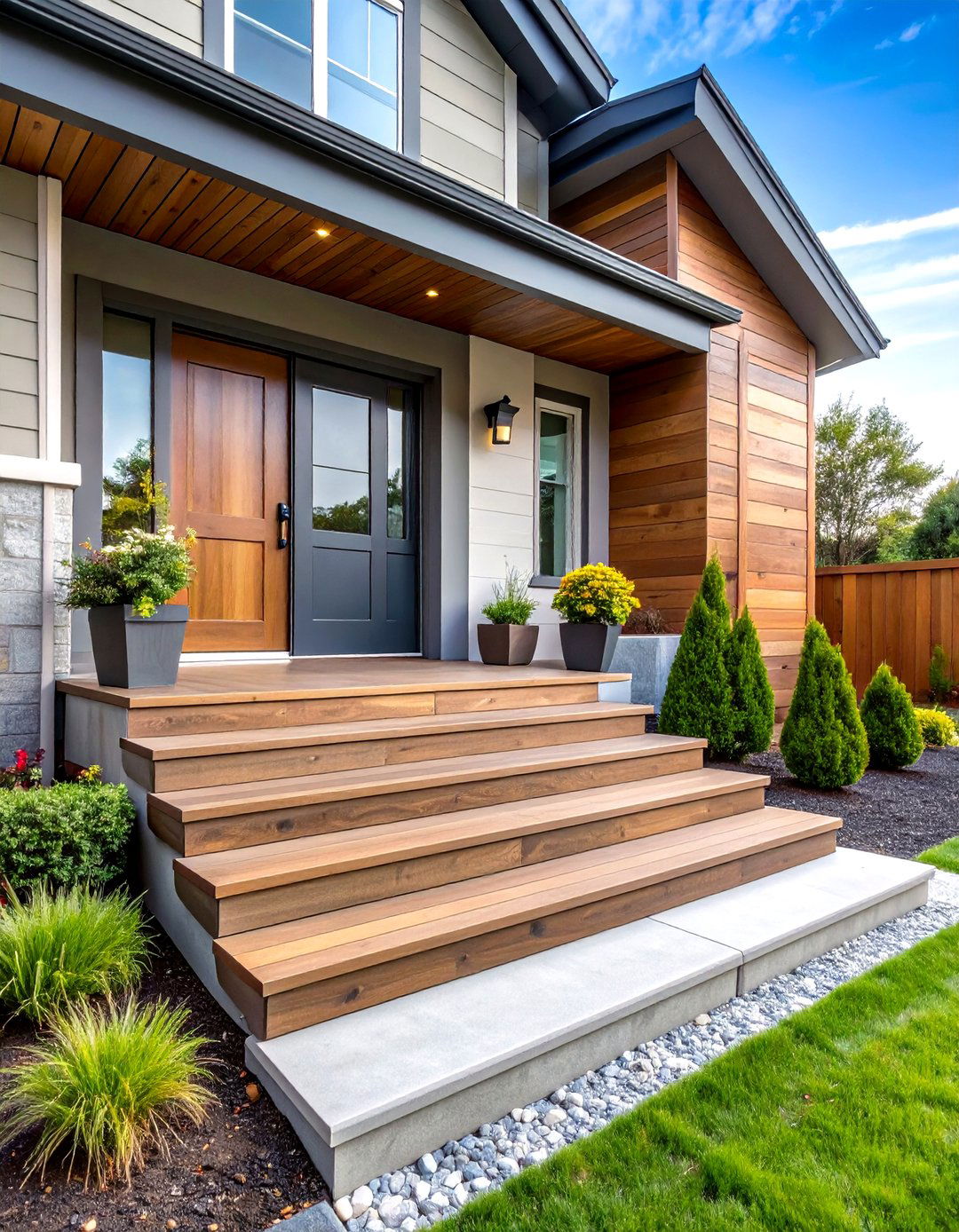
Overlay an existing concrete stoop with hardwood or composite decking boards, leaving expansion gaps and ventilated edges. The concrete offers stability, while the timber surface adds warmth underfoot — a budget-friendly way to refresh cracked front steps without full demo.
14. Recycled-Aggregate Concrete Front Steps

Specifying 30 % recycled crushed glass or reclaimed concrete in the mix reduces carbon footprint while adding subtle sparkle to front steps. Finish with a light grind-and-seal to expose colored aggregate; the polished surface resists staining better than broomed slabs.
15. Permeable Paver Front Steps for Better Drainage
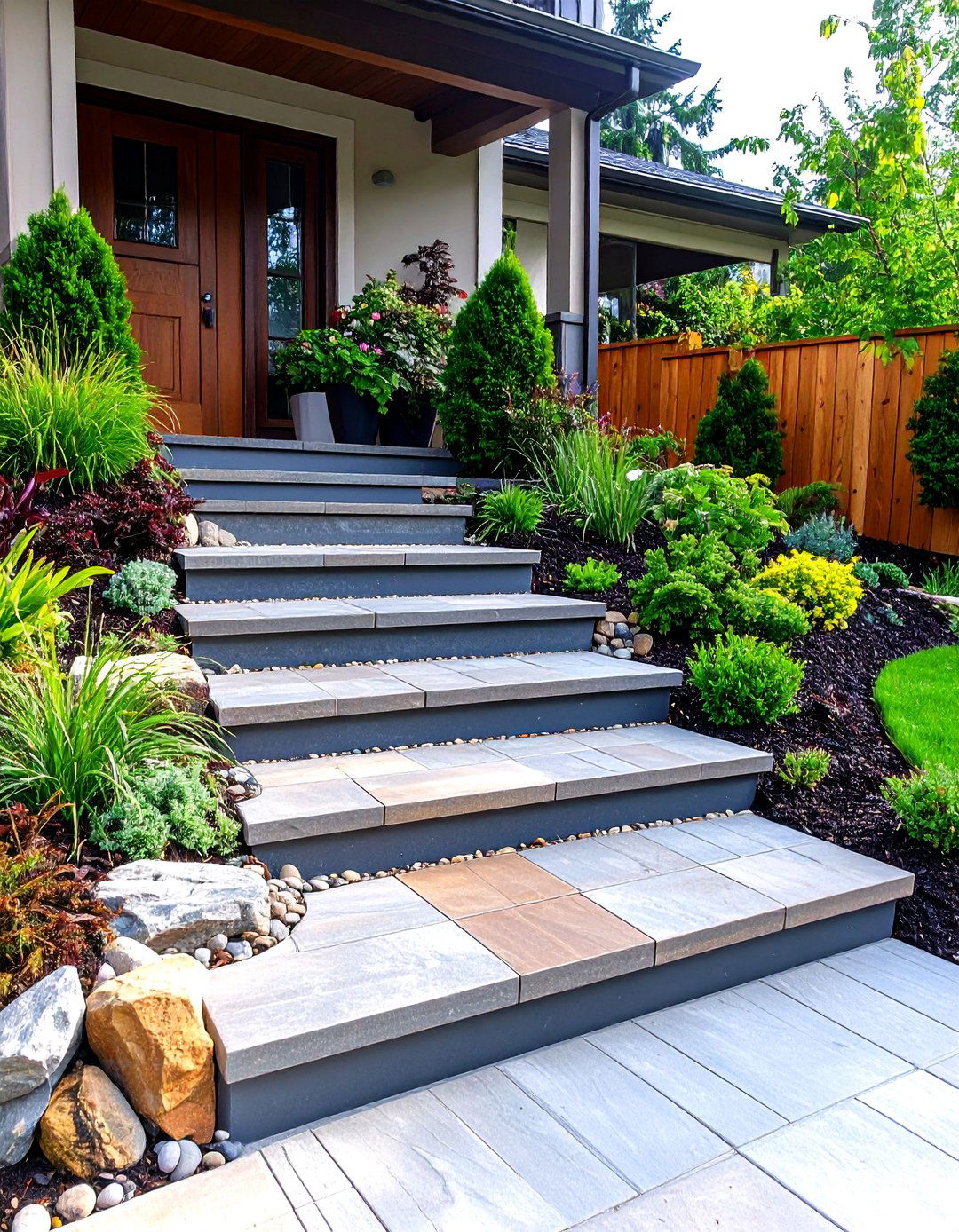
In rain-prone zones, permeable plastic grid pavers filled with stone let water percolate through treads, easing runoff toward planting beds. Edge each step with weathering-steel risers to retain the aggregate and create crisp lines.
16. Heated Snow-Melt Front Steps
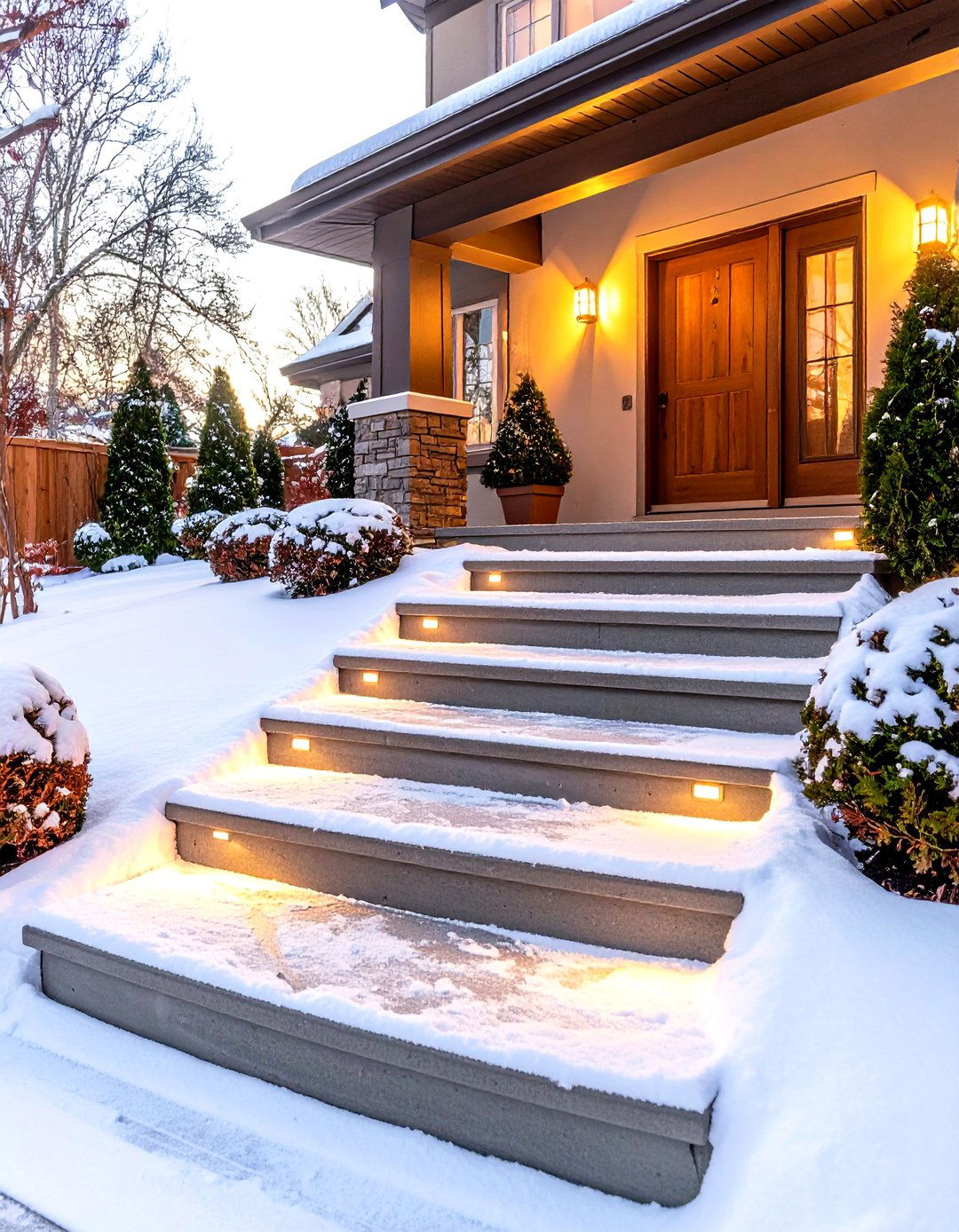
Hydronic or electric cables embedded in concrete treads keep winter ice at bay and extend the surface life by avoiding harsh salts. Tie the system to a moisture-sensor thermostat so it activates only when precipitation meets freezing temps, saving energy.
17. Slip-Resistant Coated Front Steps
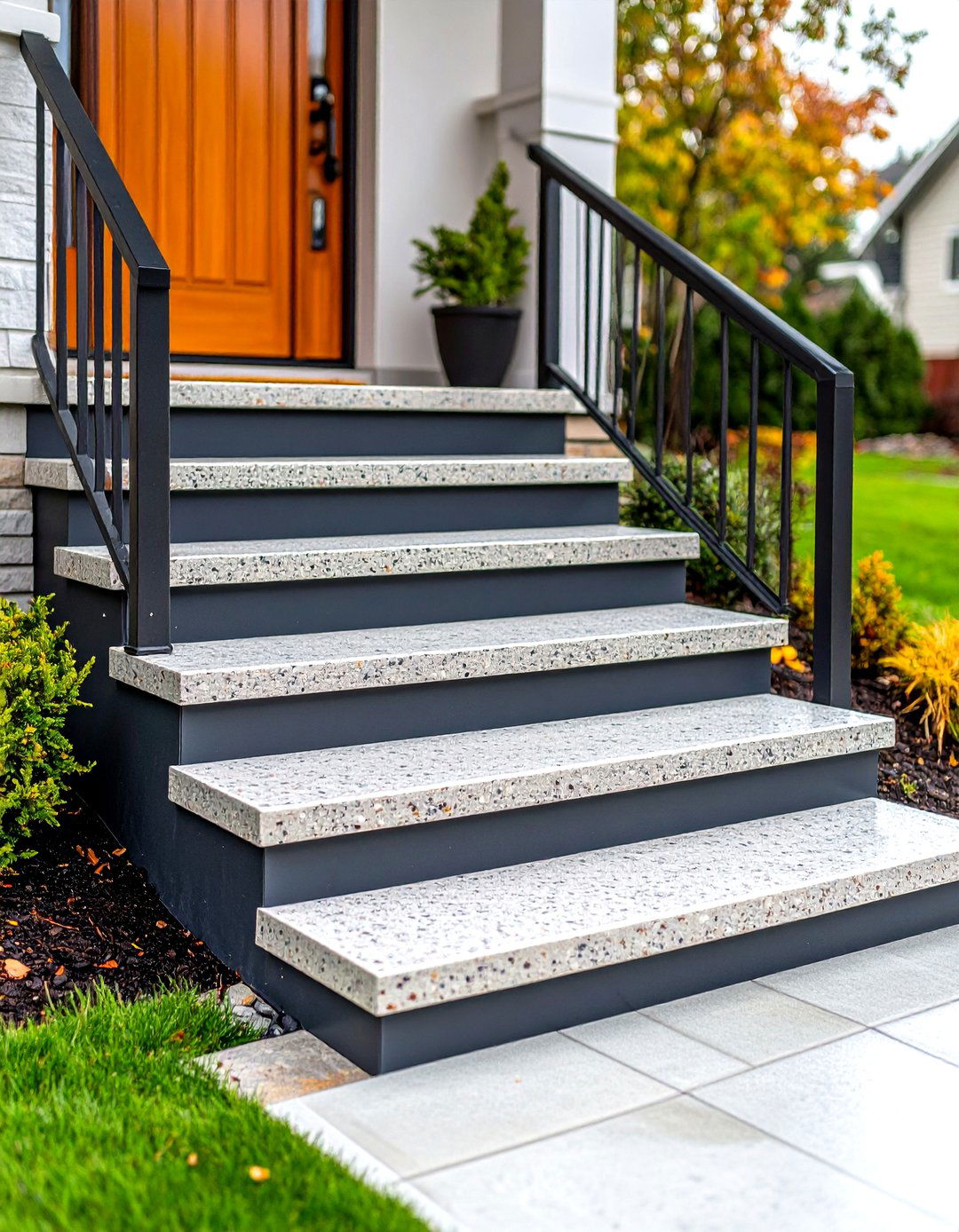
A clear, grit-infused sealer rolls onto existing concrete, tile, or stone, adding traction without hiding the material’s beauty. One afternoon’s labor delivers a tested coefficient of friction increase, insurance for kids and visitors alike.
18. Slim Metal Handrails to Complement Front Steps

Modern cable or flat-bar steel rails installed within code height supply fall protection without visual clutter. Powder-coating grids in the same hue as window trim ties the staircase to the façade, and integrated LED post caps echo step lighting.
19. ADA-Friendly Shared Ramp and Front Step Design
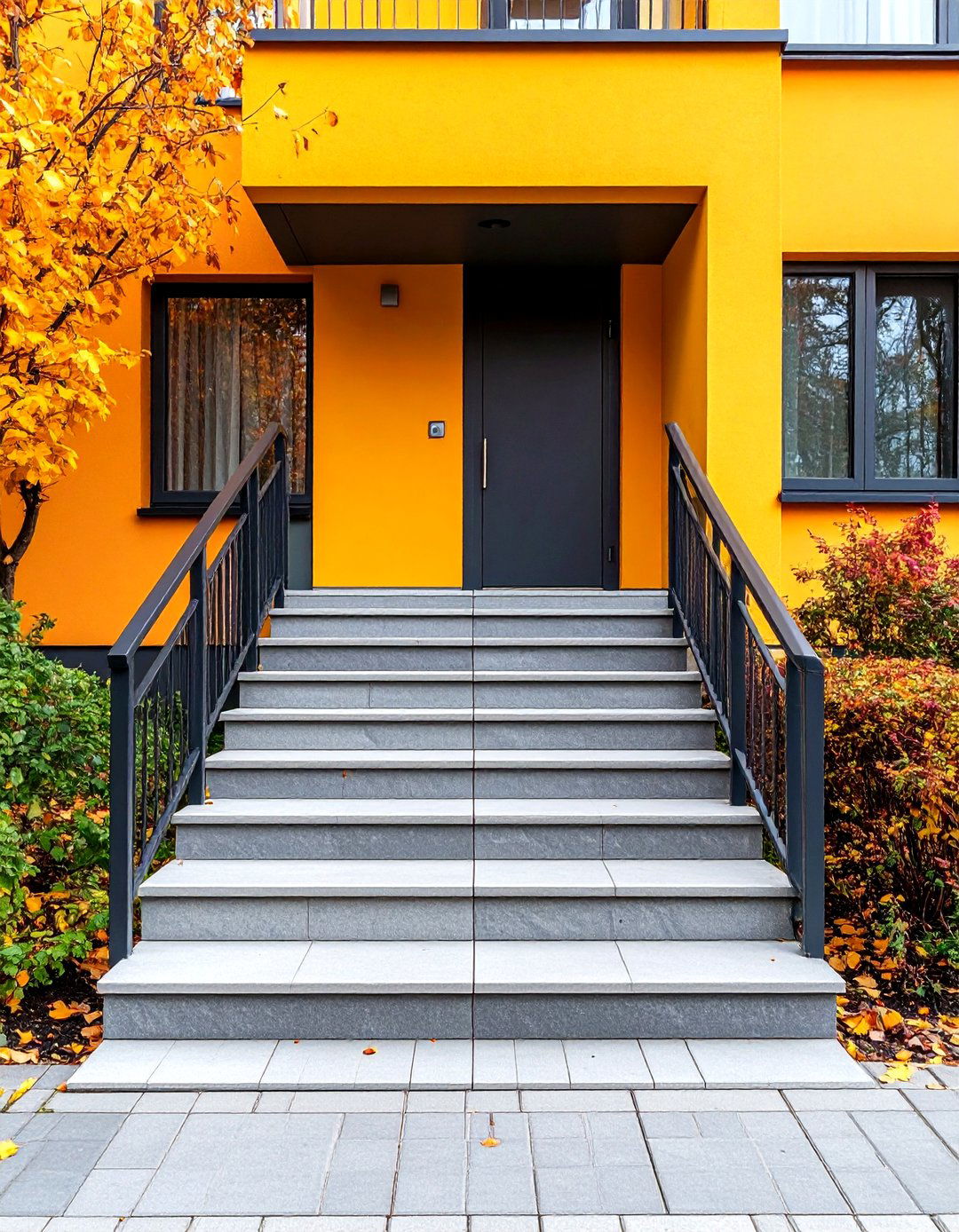
Blend a 1: 12 sloped ramp parallel to traditional front steps so wheelchair users and parents with strollers share the main entry, not a side door. Using the same cladding and handrail style keeps universal access invisible but effective.
20. Xeriscape Transition Front Steps
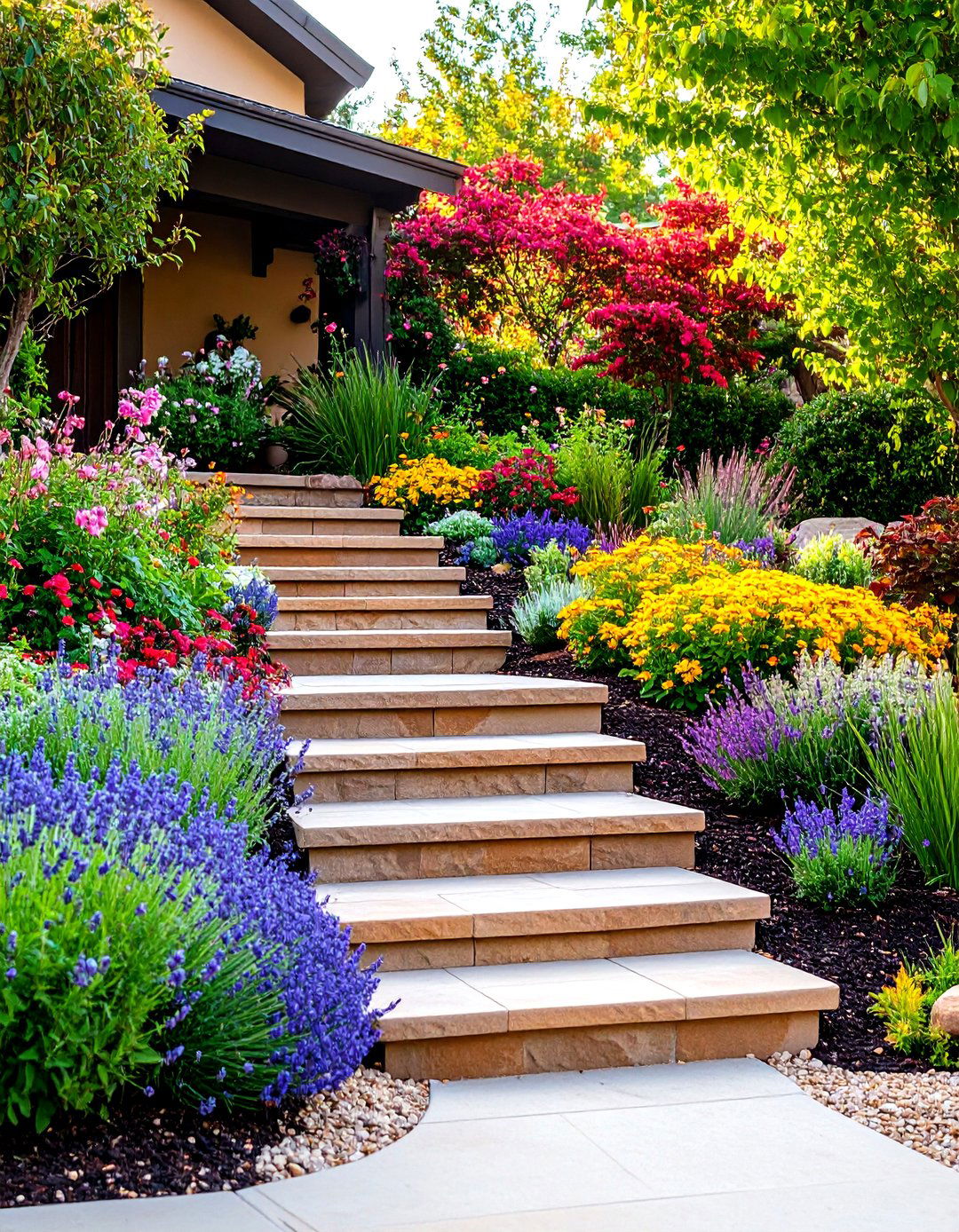
Border front steps with drought-tolerant gravel swales and low-water perennials, catching runoff while softening hard edges. Raising the first tread slightly above grade creates a threshold that deters mulch creep and frames the planting.
21. Platform-Seating Front Steps
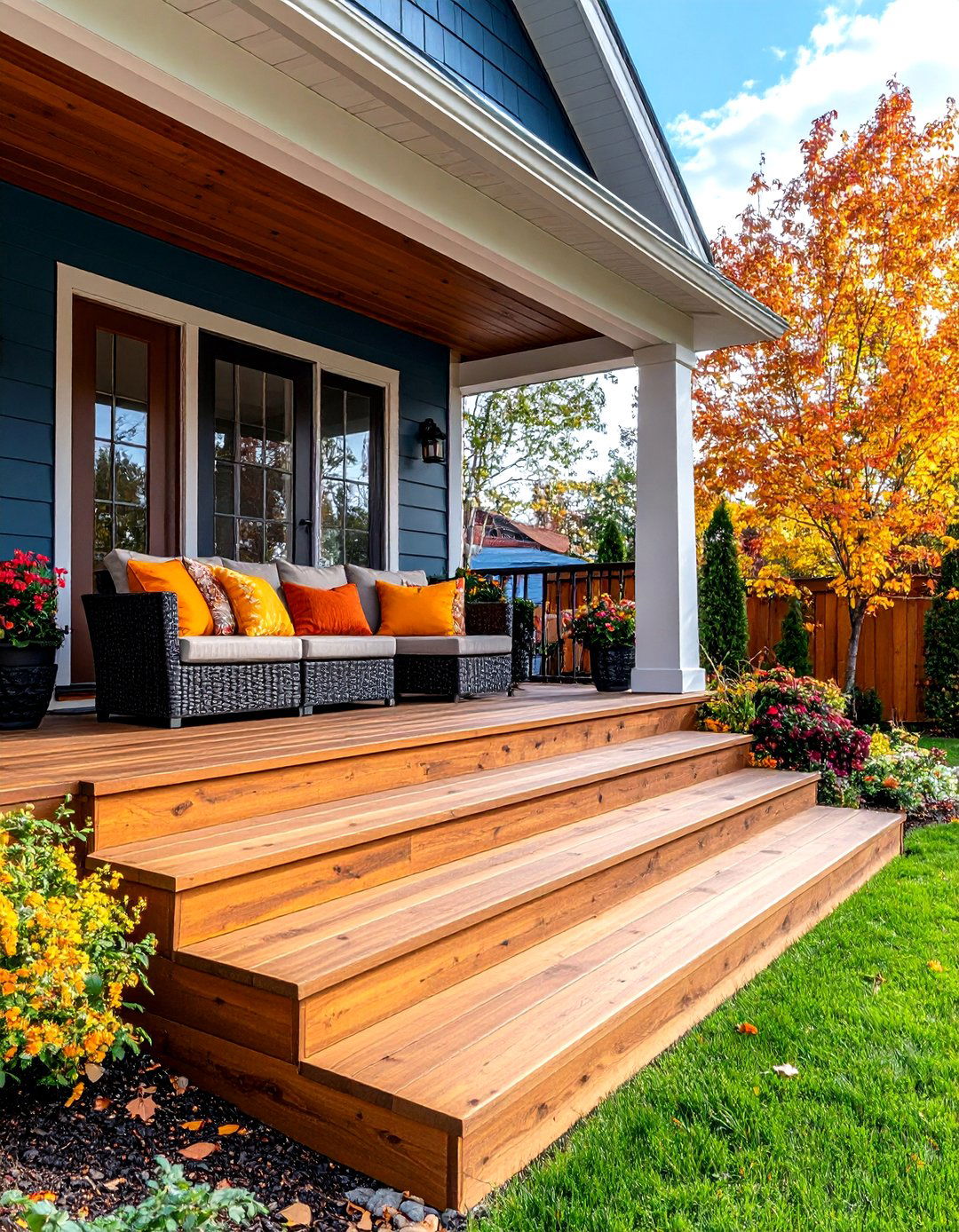
Extra-deep 24-inch treads double as casual seating during neighborhood chats, turning front steps into a mini porch even when square footage is tight. Use thermally modified wood for splinter-free comfort and stain in a semitransparent tone for longevity.
22. Curved Front Steps Hugging the Landscape
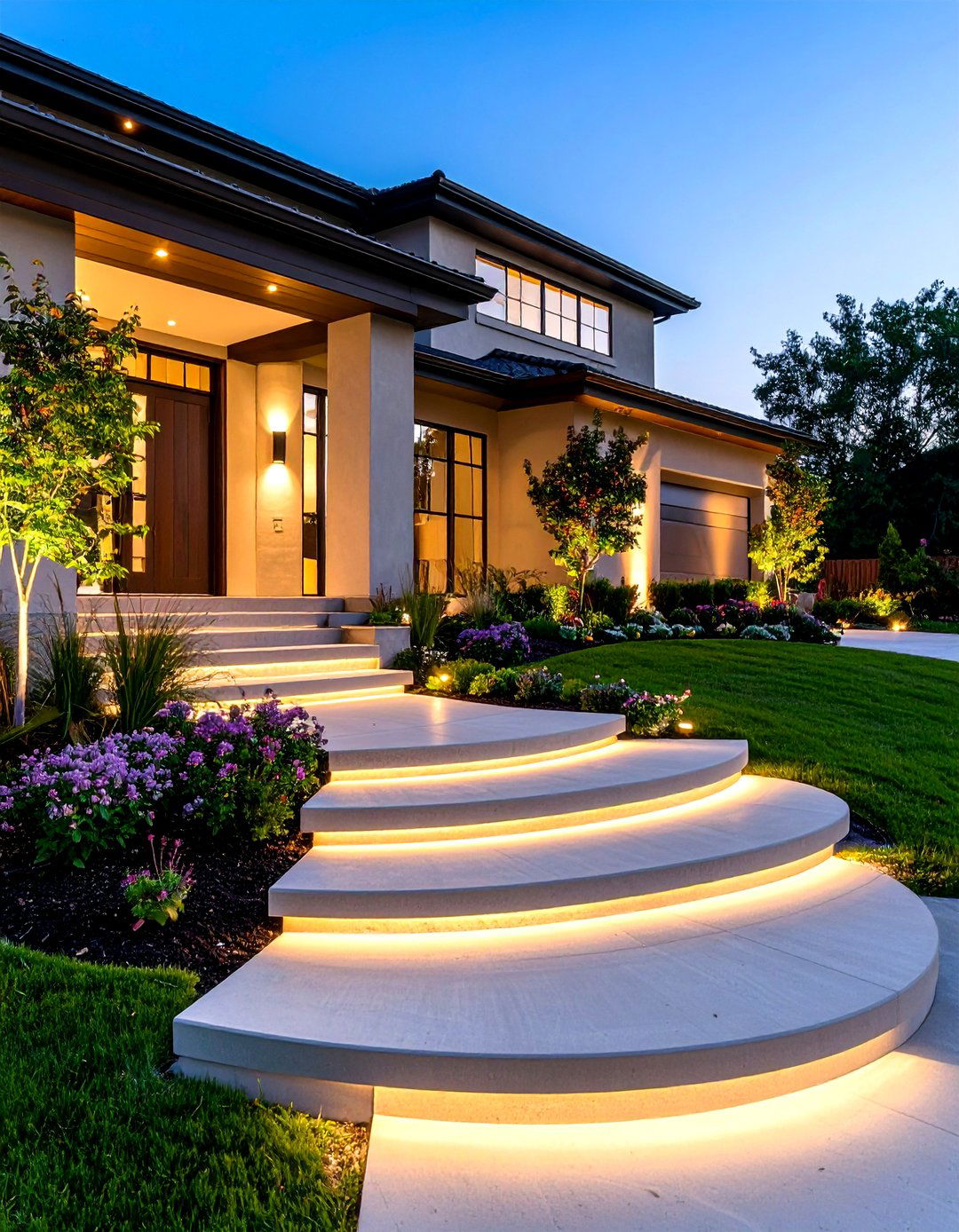
A gentle radius softens formal façades and guides visitors naturally toward the door. Form curved risers with flexible plywood before pouring concrete, or kerf-cut stone units for tight joints. Lighting placed low along the arc accentuates the sweep.
23. Sensor-Activated LED Path Front Steps

Motion sensors tucked under the bottom nose trigger soft illumination only when needed, reducing light pollution while boosting safety. Choose low-voltage drivers compatible with smart-home hubs so lights integrate with security cameras.
24. Storage Drawer Front Steps
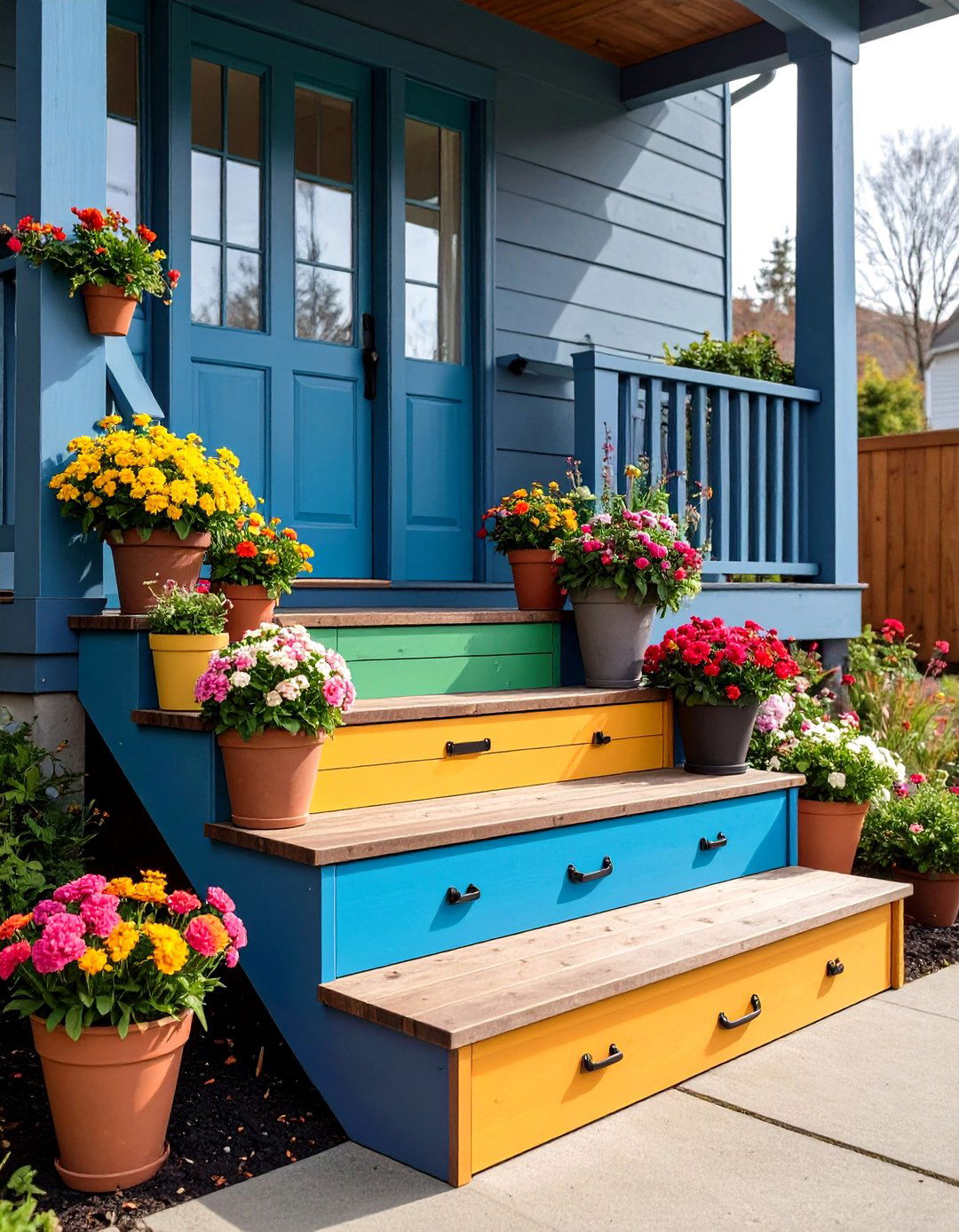
Box out the lowest two treads to create pull-out drawers perfect for garden gloves or kids’ chalk, keeping the porch tidy without adding a separate bench. Use marine-grade plywood carcasses and weather-sealed fronts for durability.
25. Mosaic Art-Pattern Front Steps
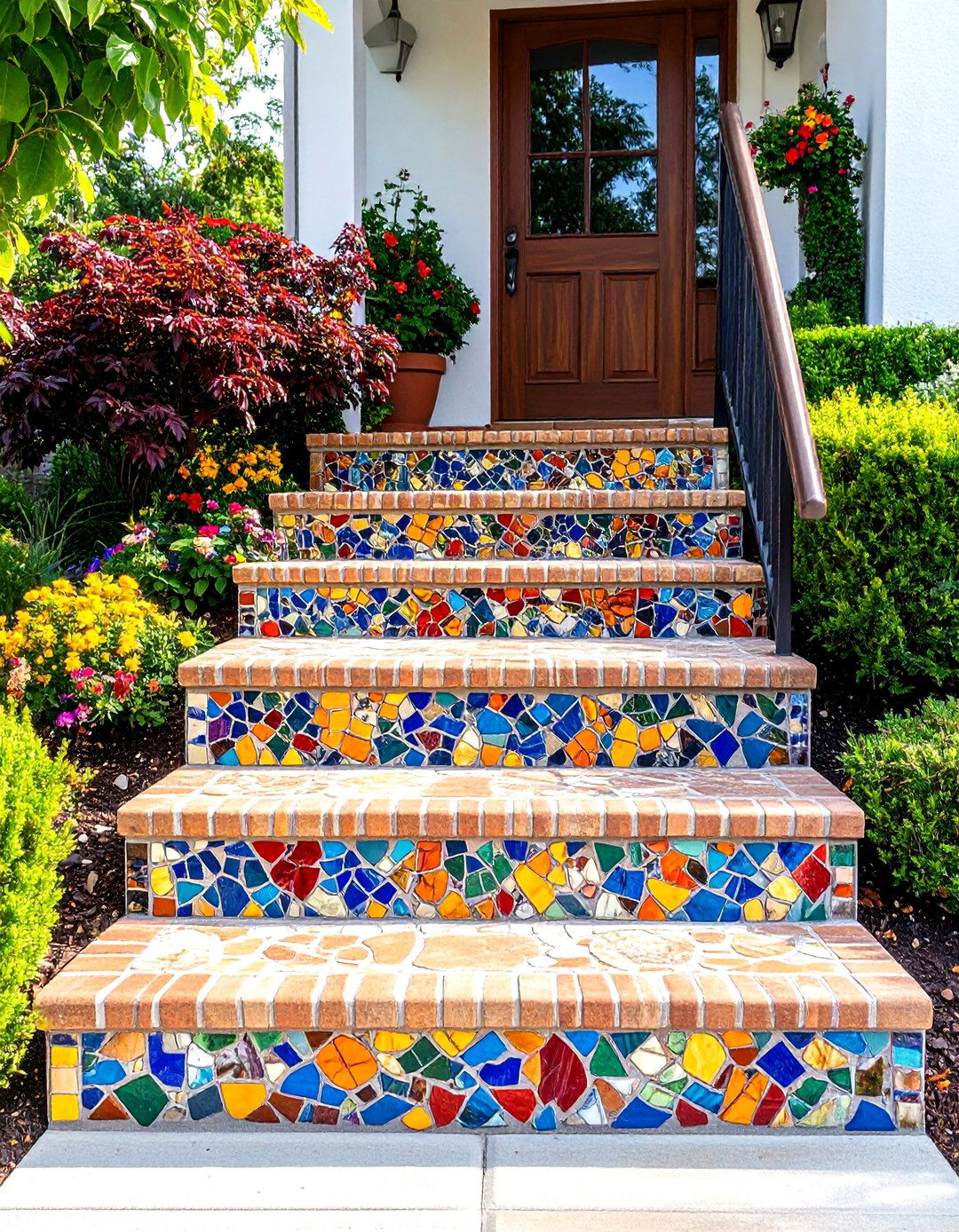
Transform risers into a storybook by commissioning a local artist to inlay recycled glass tesserae that form house numbers, vines, or geometric motifs. Finish with a UV-stable epoxy grout so colors stay vivid under harsh sun, turning every entry into a conversation starter.
Conclusion:
Upgrading front steps is more than a cosmetic tweak — it’s an opportunity to improve safety, sustainability, and daily enjoyment while reinforcing architectural character. Whether you choose permeable pavers for storm-smart drainage, floating GFRC slabs for sculptural drama, or simple slip-resistant coatings for peace of mind, each idea places function and beauty on equal footing. With thoughtful materials, lighting, and landscaping, your front steps can welcome guests, showcase personal style, and stand up to future codes and climates — one well-considered tread at a time.


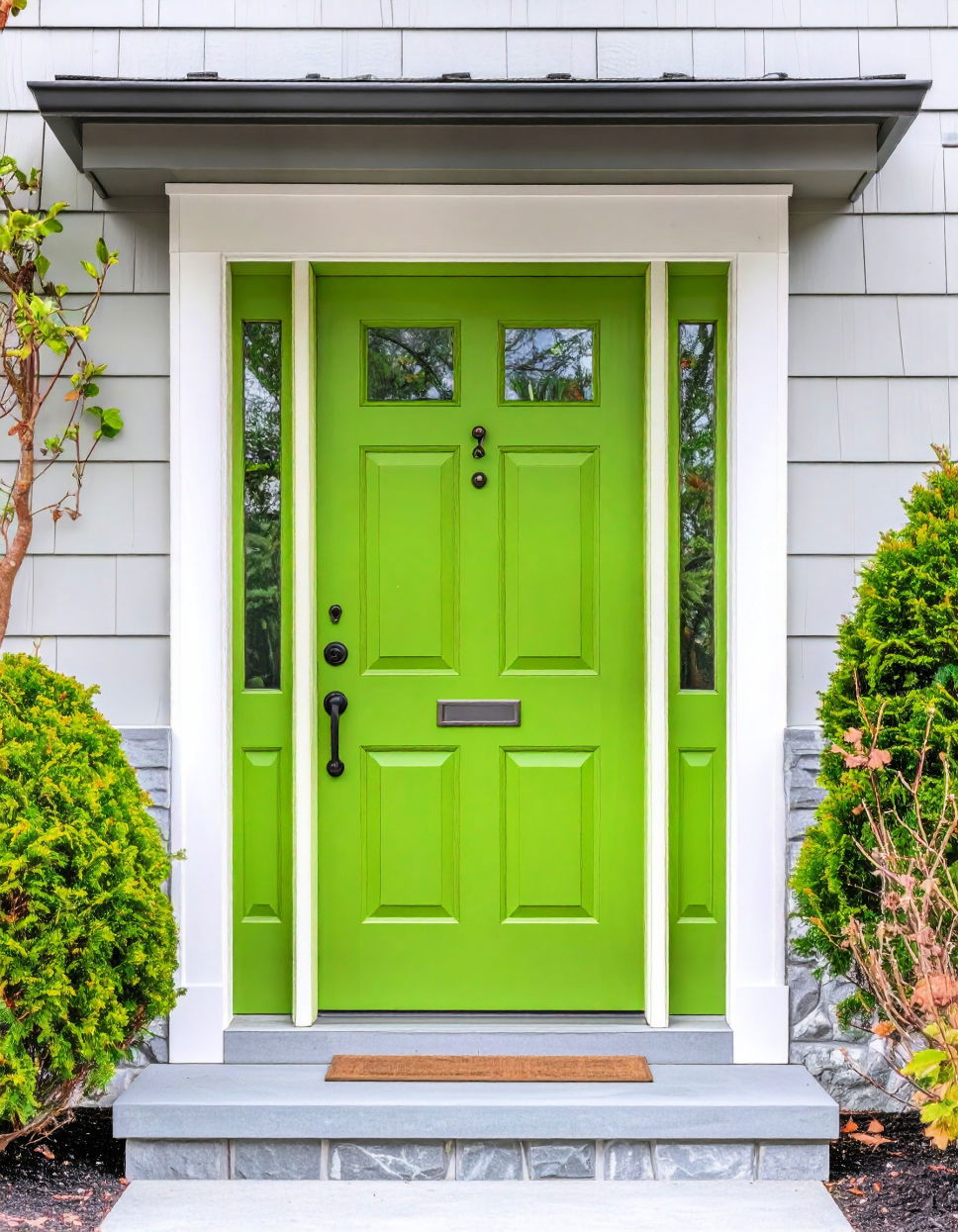
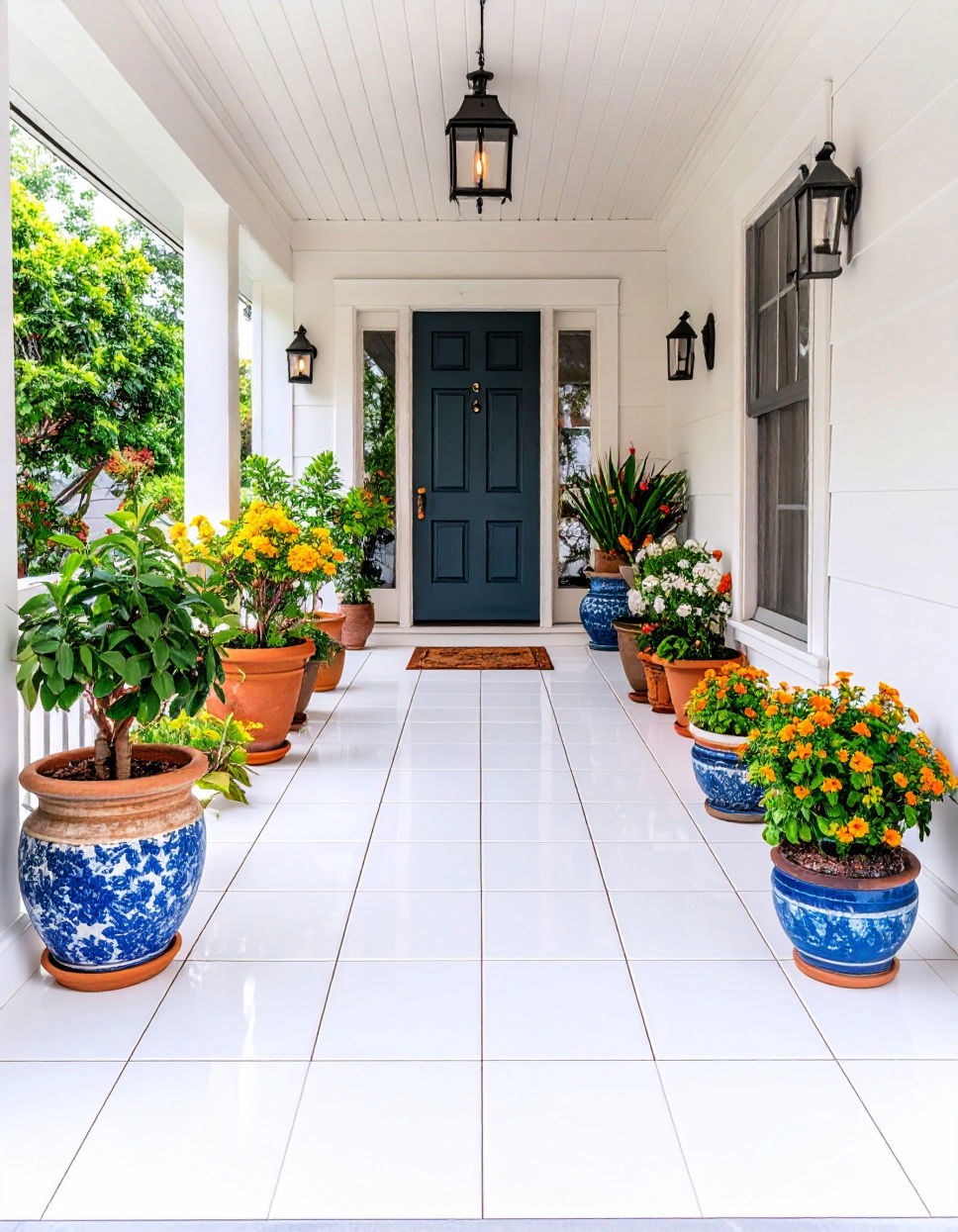


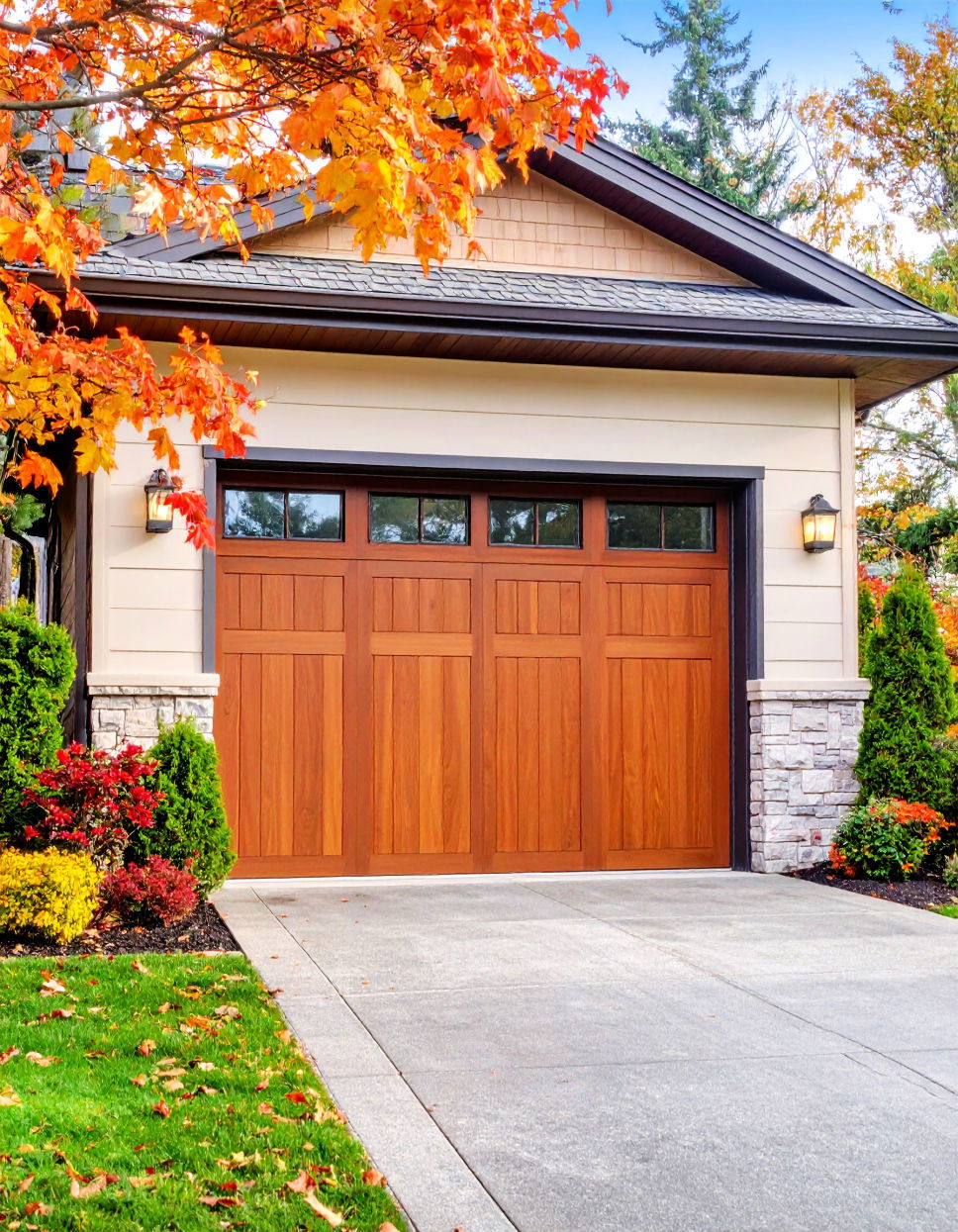

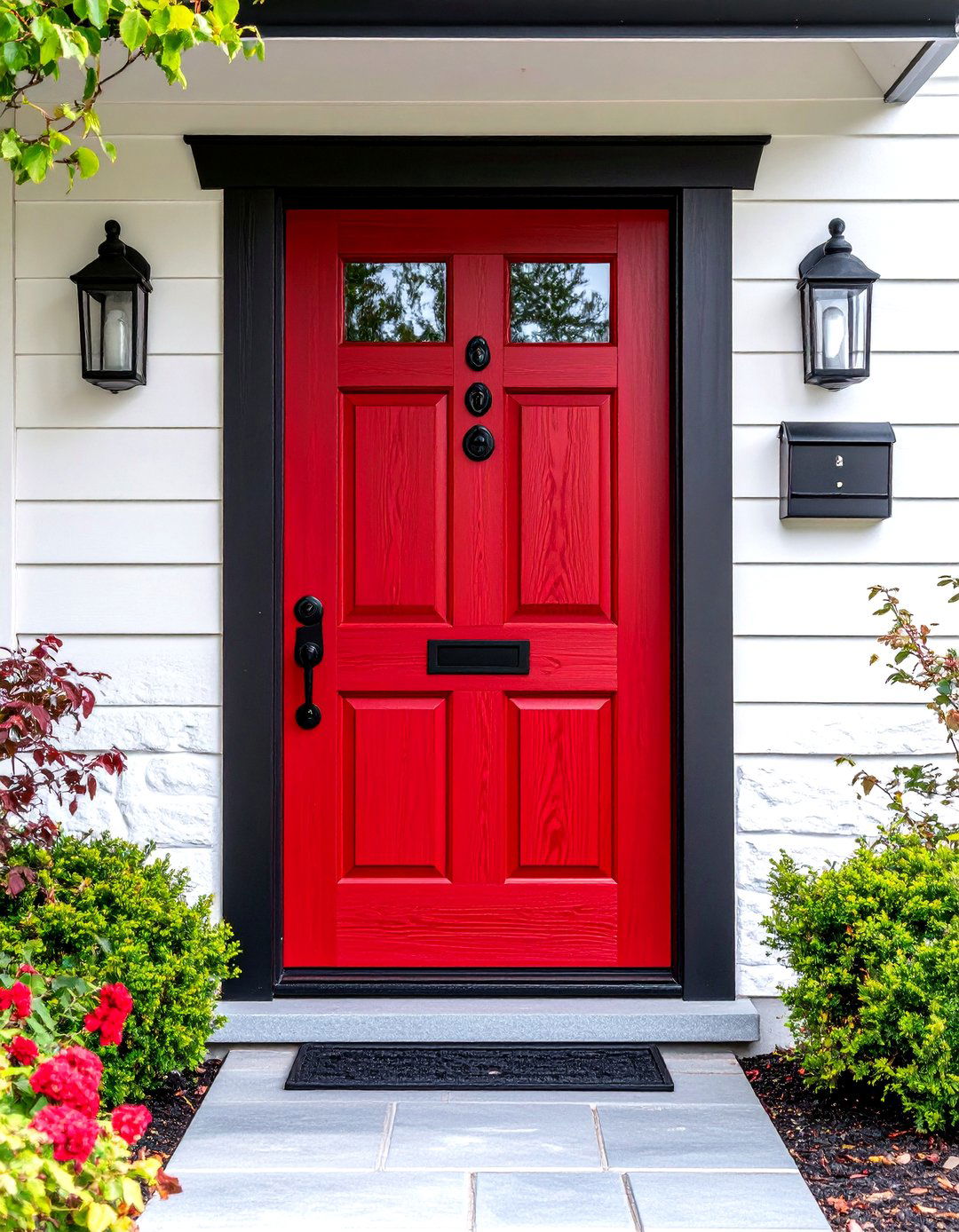
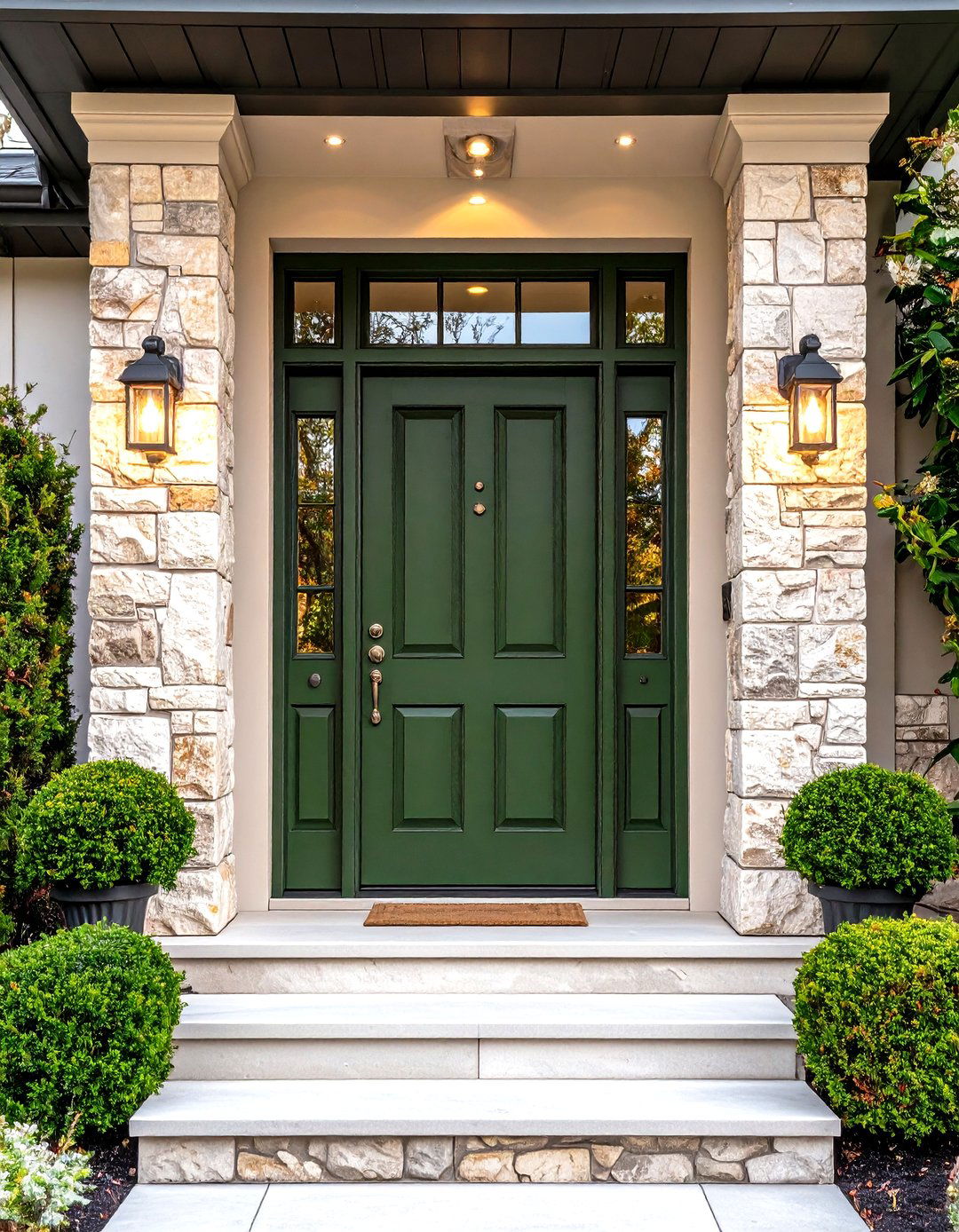
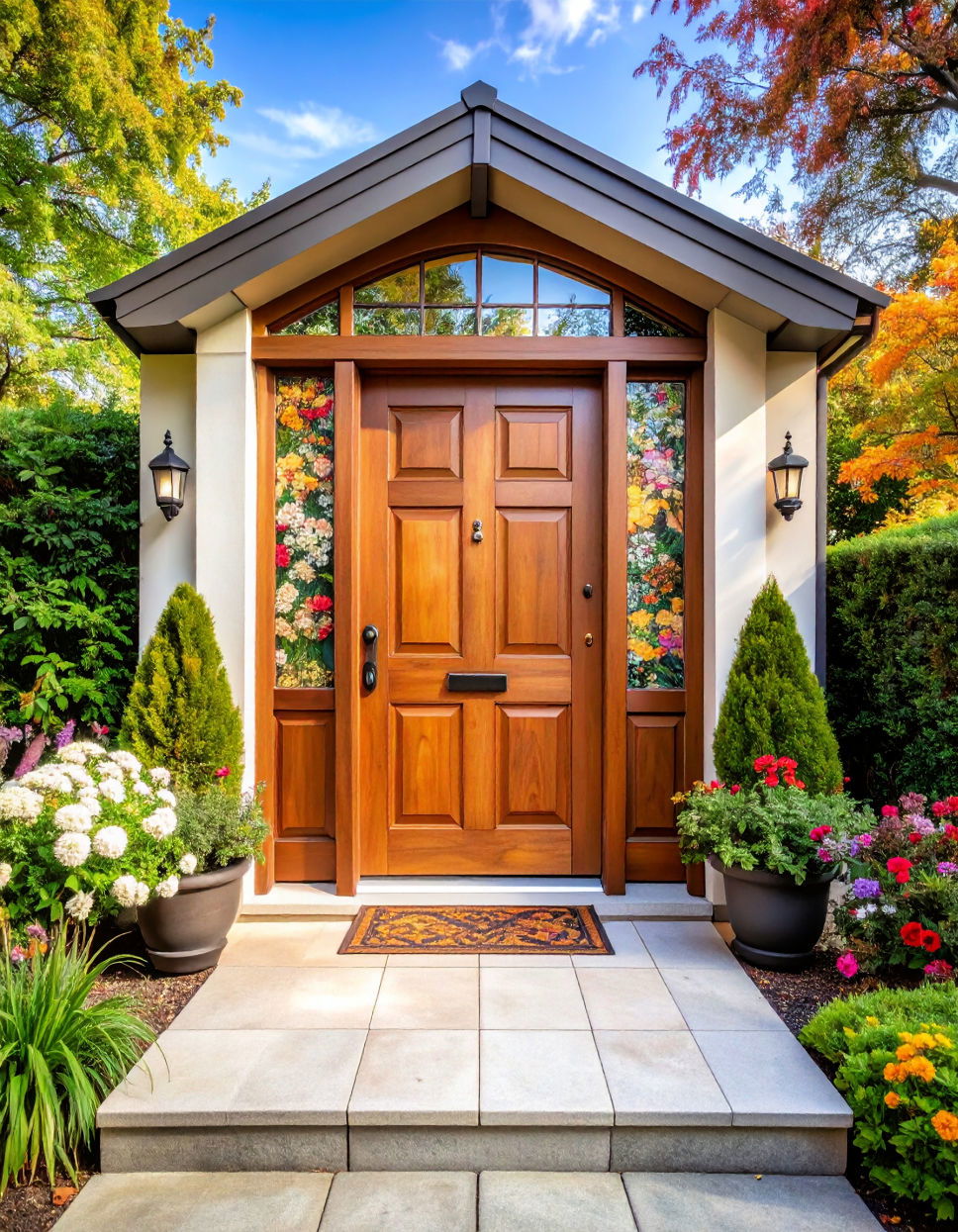



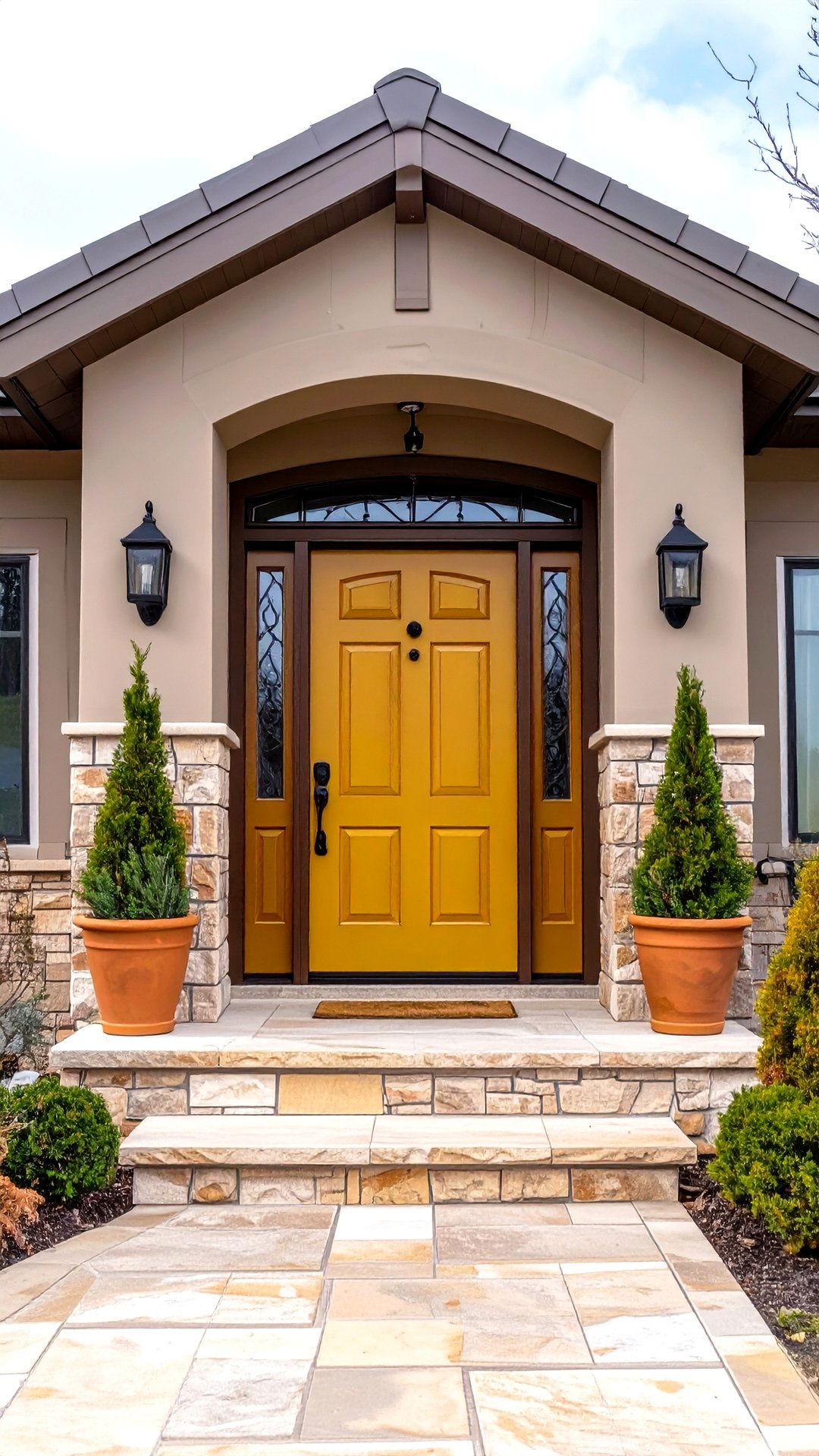


Leave a Reply